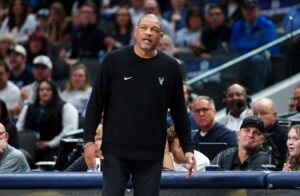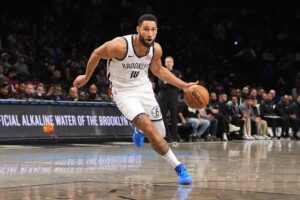The Denver Nuggets find themselves at a crossroads with Michael Porter Jr. (MPJ). On one hand, he’s a critical part of the team’s offense as a prototypical 3-and-D wing. On the other, the Nuggets are navigating a financial tightrope, dangerously close to the second apron of the NBA’s salary cap. With MPJ’s sizable contract and his value as a shooter and rebounder, the Nuggets have a significant decision to make. Should they keep him as part of their championship core or use him as a trade asset to bolster their roster depth? That’s the Michael Porter Jr. conundrum the Nuggets have to navigate.
NBA Business: The Nuggets Have a Michael Porter Jr. Conundrum
MPJ’s Current Value
In the 2023-24 season, Porter Jr. delivered solid numbers, averaging 16.7 points, 7.0 rebounds, and 1.5 assists per game. His shooting efficiency remained a key part of Denver’s offense, with Porter hitting 48.4% from the field and 39.7% from beyond the arc in 81 games. His size at 6’10” allows him to shoot over defenders with ease, and his career 41.0% three-point shooting showcases his elite ability to space the floor.
However, MPJ’s contributions are not without limitations. He’s often criticized for his singular focus on scoring( Michael the-possession-ends-here Porter Jr). While he can knock down threes and score over defenders, his playmaking is almost nonexistent, with just 1.5 assists per game. This one-dimensional offensive style limits his potential to make a significant impact when his shot isn’t falling.
On the defensive end, MPJ is serviceable but inconsistent. When locked in, he can make defensive plays, and his 7.0 rebounds per game make him valuable in securing possessions. Yet, his overall defense is not elite, which could be a factor for teams considering trading for him.
The Financial Dilemma
Porter Jr.’s contract adds complexity to the Nuggets’ decision-making. He’s currently in the second year of a five-year, $179.3 million deal, with $114.9 million owed over the next three seasons. His salary for the 2024-25 season is set at $35.8 million, which is a significant figure for a team already close to the second salary cap apron. Denver is less than $7 million away from this punitive threshold, and the penalties for exceeding it include restrictions on trades, signings, and draft pick usage.
Because of this, Porter Jr.’s contract is the most logical to shop on the trade market if the Nuggets want to bring in an All-Star talent or split his salary into multiple high-end role players. Trading him could offer Denver more roster flexibility and depth, crucial in their quest to defend their title.
Injury History Concerns
Another aspect of the MPJ conundrum is his injury history. While 2023-24 was his most durable season, playing in 81 games, Porter Jr. has struggled with back issues throughout his career. Two back surgeries and subsequent issues with drop foot and ankle problems have raised concerns about his long-term durability. He currently wears a brace to keep his left foot in dorsiflexion, highlighting the seriousness of his condition.
This injury history presents a double-edged sword. On one side, Porter’s ability to play through pain showcases his toughness and grit, qualities any team would value. On the other, his unique health concerns make it nearly impossible to predict if his injury issues will improve or worsen as he ages. This uncertainty could reduce his trade value despite his obvious talents.
The Potential Trade Market
Porter Jr. represents a significant trade asset for the Nuggets. His contract is large enough to facilitate deals for top-tier players or multiple key role players. One possibility would be using him in a trade for a player like Brandon Ingram, an All-Star talent who could bolster Denver’s championship push. Alternatively, they could split his contract into smaller, more flexible pieces that fit better within the team’s salary cap constraints.
However, teams across the league may hesitate to take on Porter Jr. due to the effect Nikola Jokic has on his performance. As the reigning MVP, Jokic elevates the players around him, including MPJ. There’s a concern that Porter Jr.’s success in Denver doesn’t necessarily translate to other teams without a playmaker of Jokic’s caliber. Furthermore, MPJ’s streaky shooting and lack of shot creation off the dribble could limit his effectiveness outside of the Nuggets’ system.
The Michael Porter Jr Conundrum
Despite the concerns, Porter Jr. remains an attractive option for many teams. A 6’10” small forward with a 7’0” wingspan who shoots over 41% from three and grabs rebounds at a high level is a coveted asset. However, his $35.8 million salary is only justifiable if he elevates his game to an All-Star level. If Porter Jr. can add more versatility to his offense, his importance to the Nuggets increases dramatically, making it harder to justify trading him.
But if he fails to develop further, trading him could be the best move for the Nuggets to avoid the second apron penalties and improve their overall roster depth. However, moving Porter would mean Denver loses arguably their best floor-spacing option. Given that the team ranked 29th in the NBA in three-point attempts last season, trading MPJ could severely limit their offensive capabilities.
This is the heart of the Michael Porter Jr. conundrum: Denver must decide whether to keep an immensely talented but flawed player or trade him in hopes of building a more versatile, balanced roster.






